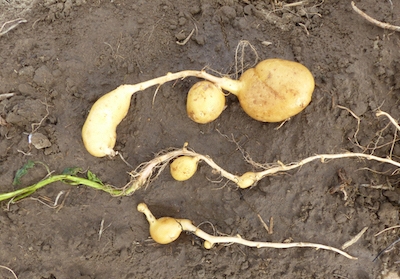
Features
Agronomy
Crop Protection
Second growth disorder reported in Ontario
Sept. 29, 2016 – Second growth is a physiological potato problem induced by soil temperatures of 24 C or above and water stress. These two factors interact to limit the tuber growth rate, causing second growth. Inadequate soil moisture alone does not result in the initiation of second growth.
Heat and drought prevailed during the 2016 Ontario growing season, which explains why second growth has been reported in some fields.
Potato varieties differ in their susceptibility to second growth. European varieties appear to be more susceptible because they were bred and evaluated in countries where the growing seasons are rarely hot.
There are three distinct types of second growth:
Tuber chaining: A series of small tubers are produced on a single stolon.
Heat sprouts: Sprouts develop from stolons or daughter tubers. The sprouts may emerge from the hills developing into leafy stems.
Secondary Tuber: Small tubers form on daughter tubers. The secondary tubers are formed on short sprouts or directly on the tuber surface. This disorder is usually associated with physiologically old potatoes. High temperatures and water stress during the growing season are major factors contributing to the physiological aging of potatoes.
Cultural practices that promote uniform growth of plants and tubers throughout the season help minimize second growth. Among them are:
● Do not plant physiologically old seed in cold, dry soil.
● Space seed pieces as uniformly as possible at planting.
● Apply an adequate amount of fertilizers.
● Maintain uniform soil moisture sufficient to meet crop needs (this was easier said than done this past season!).
September 29, 2016 By Eugenia Banks
 Tuber chaining Second growth is a physiological potato problem induced by soil temperatures of 24 C or above and water stress.
Tuber chaining Second growth is a physiological potato problem induced by soil temperatures of 24 C or above and water stress.Print this page